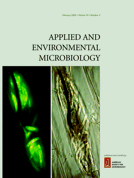Sukno S.A, Garcia V.M, Shaw B.D. and Thon M.R. 2008. AEM 74: 823-832. COVER IMAGE
Abstract:
Colletotrichum graminicola is a filamentous ascomycete that causes anthracnose disease of maize. While the fungus can cause devastating foliar leaf blight and stalk rot diseases, little is known about its ability to infect roots. Previously published reports suggest that C. graminicola may infect maize roots and that root infections may contribute to the colonization of aboveground plant tissues, leading to disease. To determine whether C. graminicola can infect maize roots and whether root infections can result in the colonization of aboveground plant tissues, we developed a green fluorescent protein-tagged strain and used it to study the plant root colonization and, infection process in vivo. We observed structures produced by other root pathogenic fungi, including runner hyphae, hyphopodia, and microsclerotia. A mosaic pattern of infection resulted from specific epidermal and cortical cells becoming infected by intercellular hyphae while surrounding cells were uninfected, a pattern that is distinctly different from that described for leaves. Interestingly, falcate conidia, normally restricted to acervuli, were also found filling epidermal cells and root hairs. Twenty-eight percent of plants challenged with soilborne inoculum became infected in aboveground plant parts (stem and/or leaves), indicating that root infection can lead to asymptomatic systemic colonization of the plants. Many of the traits observed for C. graminicola have been previously reported for other root-pathogenic fungi, suggesting that these traits are evolutionally conserved in multiple fungal lineages. These observations suggest that root infection may be an important component of the maize anthracnose disease cycle.
PDF: sukno etal 2008

